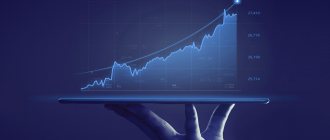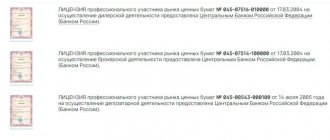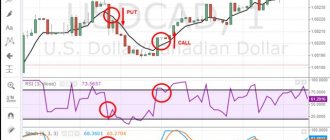Image: Unsplash
Anyone who is interested in the field of stock investments has come across references to the concept of margin trading. But what is it and what is this tool for? Let's look at it in our new material.
Note
: any investment activity on the stock exchange is associated with a certain risk, and when trading you can lose money - this must be taken into account. We do not encourage you to use the possibility of margin trading, but we tell you about this tool. In addition, to make investments you will need a brokerage account, which can be opened online. You can study the trading software and practice performing transactions using test access with virtual money.
What is margin and margin trading in simple words
Margin trading is a transaction with financial assets that involves the use of borrowed funds provided by a stock market broker or forex dealer on the security of the purchased assets.
In practice, this means that the trader can use more money than he has, but in losses he is limited only by his capital.
Margin is the amount of equity that is required to conclude a transaction with a certain asset with the participation of available borrowed capital.
What is initial margin and minimum margin
The initial requirements for margin trading are the amount of funds required to open a position, taking into account the leverage provided.
The minimum margin, in turn, shows the level of funds upon reaching which the trader’s position can be forcibly closed by the broker at market value, and a loss is recorded.
How leverage works
To determine the principle of operation of margin trading, I will give a simple mathematical example.
If a trader has 10,000 rubles in his account, the broker is ready to provide the client with a leverage of 1:2, then the participant can open a position in the amount of 20,000 rubles.
At the same time, he must be aware that a 50% movement in asset prices in the opposite direction will make him bankrupt. The same principle works the other way around: a 50% movement in quotes into the positive zone will result in the trader’s account doubling.
The role of a broker in margin trading
The broker provides tools and opportunities for margin trading, but, of course, it does not do it for free. Positions opened with borrowed money will be subject to the lending rate.
In this case, the broker excludes the possibility of the client losing the borrowed funds issued to him. To do this, the financial agent monitors the status of traders' accounts and forcibly closes the client's positions if his level of funds approaches the minimum indicators established by the brokerage firm itself.
Why resort to margin trading?
Traders can use margin trading to:
- increase current income from transactions with financial assets;
- hedge the opening of a position.
What does leverage depend on?
The level of borrowed funds provided for trading may depend on the following factors:
- Legislative regulation.
- Liquidity and volatility of assets against which a margin position is opened.
- Qualifications and legal status of the investor.
- Market conditions.
- Other parameters set by a specific broker or exchange.
What is a margin call and when is it placed?
Margin call is a risk limit, after which the broker requires the client to replenish his account with the amount required for collateral or decides to close the client’s positions with market orders.
That is, the broker issues a margin call after the funds in the trader’s open positions fall to the minimum margin level.
Basic Leverage Operations
A trader using margin trading can perform the following operations:
- to purchase an asset (LONG);
- to sell an asset without covering (SHORT).
How to sell high-margin products
1. Make a list of products that you could sell. Typically it includes the following items.
Seasonal goods
Winter comes unexpectedly, and summer, in general, too. Millions of citizens suddenly realize that they need seasonal clothing, sports and travel goods, tents and barbecues. We decided, went to search on the Internet - and here you are with a lucrative offer. And no high markup will stop a person from wanting to buy what he needs!
Seasonal products in the online store
Natural flowers
The markup on this product reaches insane proportions: in Holland one tulip costs one ruble, in our retail stores it costs 50 rubles and more. Here it is, your chance: you can make a lower markup and still sell at a profit for yourself and the client.
Selling tulips in Holland
Hand-made products
This is where there is room for markups - produce it yourself, set the price yourself. Well, or you are looking for talented craftsmen who are willing to give you a portion of the profits. Anything can be considered handmade: clothing and shoes, jewelry, toys and dolls, home decor products, and so on. The cost of such products is usually low.
Hand-made goods
Craft beer and luxury alcohol
Alcohol is always sold at a premium, no matter whether offline or online. Craft beers are in fashion now, but luxury alcohol will always be fashionable. The main thing is to comply with all legislation and trade under a license.
Elite alcohol
Elite tea and coffee
This is also a long-proven method that brings good margins to businessmen. Especially if you find a supplier with a low purchase price - you can do it right in China, where tea grows - and make a markup of 400 percent.
Elite tea
Attributes for holidays
It would seem like a small thing, but what an income! All these funny caps, garlands, balls, personalized cards, inflatable numbers are bought for pennies, and are sometimes sold with almost thousand markups. Holidays happen every day, so there will definitely be demand.
Goods for holidays
Example of margin trading on Forex
Lot sizes in the Forex market reach large sizes, often inaccessible to retail investors.
Let's assume that a trader has $1,250 in his account. He believes that the British pound against the dollar (GBP/USD) will rise in the near future and wants to make money on it.
If one trading lot for the pair (GBP/USD) costs about $125,000, then the client needs to use leverage in the coefficient to purchase it:
125 000 / 1 250 = 100 (1:100).
If a trader wants to buy a fractional lot equal to 0.05 of the full size, then he will have enough leverage in the amount of:
125 000 * 0,05 / 1 250 = 5 (1:5).
Moreover, in the first case, the trader will lose all his funds if the price moves against him by 1%, and in the second - if the pound/dollar quotes fall by 20%.
Long position long
Operation long (from English “long, long”) is, in essence, the purchase of an asset. This name indicates that the position can be held for a long time and does not require coverage in the future.
For example, if an investor in the securities market bought a share of a company, he is said to have made a long trading operation.
However, when using margin funds, the position begins to depend on the level of margin and market quotes, which carries additional risks.
Opening a short position
Short (from English - “short”) is a game to reduce an instrument or sell an asset that the investor does not initially have.
This position operates on the following principle. For example, a trader believes that stock prices will decline in the near future and wants to make money on it. Let the current price of securities be equal to 100 rubles.
The client asks the broker to lend him such shares and then sells them on the market at a price of 100 rubles. After some time, the securities really fell in price, now they cost 80 rubles. per piece, then the client goes to the market buys these shares and returns them to the broker. Through such an operation, the trader will earn a profit of 20 rubles.
Another important point is that the broker will agree to lend shares only if the client has enough available funds to cover the position in the future, taking into account the margin trading rates provided to him.
In banking
The concept of margin is central to the banking business. In particular, determining the interest margin is particularly important. It represents the difference between interest received and interest paid. In other words, between the interest received from borrowers and the interest paid to lenders. Therefore, the bank needs to correctly set interest rates on loans and deposits in order to have a sufficiently high interest margin. Accordingly, if a bank lowers interest rates on loans, it will also lower the yield on deposits so that the interest margin does not decrease. And vice versa.
Examples of calculating the volume of a margin position
For example, an investor has 100,000 rubles in his account for trading on the stock market.
Let's assume that a trader wants to buy the maximum number of shares in his portfolio (risk rate = 17%). Thus, the highest rate for using the securities of this issuer will be calculated as the amount of funds/risk ratio. It turns out:
100,000 / 0.17 = 588,236 rubles.
With an MTS share price of 270 rubles. per piece the maximum number of securities available for purchase by an investor for 100 thousand rubles will be equal to 2,139 pieces. or 213 lots (1 standard lot accumulates 10 MTS shares).
Now I'll complicate things a little and change the portfolio structure. In this case, the investor decided to build his trading from several positions: 100 shares of Lukoil at a price of 5,400 rubles. per piece (risk rate = 17%) and 200 shares of Mvideo at a price of 420 rubles. per piece (risk rate = 50%).
Such a portfolio will be equal to:
100 * 5400 + 200 * 420 = 624,000 rub.
Now I will try to calculate the minimum margin level for this portfolio:
(100 * 5400) * 0.17 + (200 * 420) * 0.5 = 91,800 + 42,000 = 133,800 rubles.
The initial level for margin trading will look like the difference between total assets and the minimum indicator:
624,000 - 133,800 = 490,200 rub.
That is, in order to reproduce the same portfolio for an investor, taking into account the margin trading opportunities provided, you need to have 490,200 rubles in your account.
Advantages and disadvantages
Among the advantages of margin trading, the following opportunities are worth highlighting:
- Using more funds than the investor has and potentially making large profits from the transactions.
- Earnings on both growth and decline of assets.
- More competent management of existing positions through instrument hedging.
- The ability to provide not only money, but also financial assets as collateral.
The main disadvantages that need to be identified when trading on margin are:
- Increased risks in transactions.
- Payment for the use of borrowed funds.
Risks and pitfalls
First of all, when building your trading, you need to take into account the market risk of losing funds due to price fluctuations.
And here it is important to note that the risk grows in proportion to the amount of leverage provided.
You should also evaluate the risk associated with the credit rate set by the broker for using margin trading services. This applies to a greater extent specifically to the stock market.
For example, this could be a rate of 15% per annum, then the potential profit from the transaction must significantly exceed this value in order for the trader to open a margin position.
Beyond this, the investor must consider simple mathematical truths. For example, having taken leverage in his trading and lost 50% of the account, in order to restore the previous level of funds, he needs to earn 100% of the current capital.
In business
The concept of business margin is closely related to the concept of product margin. The latter is a broader term. It means the ability of a business to bring its owners net profit on invested capital per year. The indicator is measured as a percentage.
Let's give an example. Let’s say an entrepreneur invested 1 million rubles in a business. A year later, the net profit amounted to 200 thousand rubles. To calculate the business margin, or rate of return, we divide the net profit by the amount of invested funds. We'll get 20%.
Knowledge of this concept is necessary not so much for business founders as for investors. For a successful investment, it is advisable to evaluate not only the profitability of the business as a whole, but also of its individual projects. The most high-margin type of business, especially in Russia, is trade.
Real reviews
Traders have varying opinions on margin trading. Some see high leverage and active debt management as only opportunity and potential rewards, while others insist on risks and potential losses.











